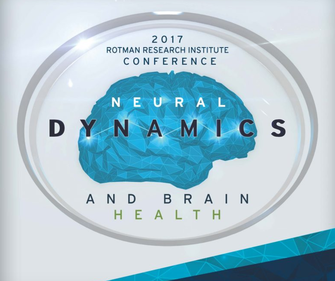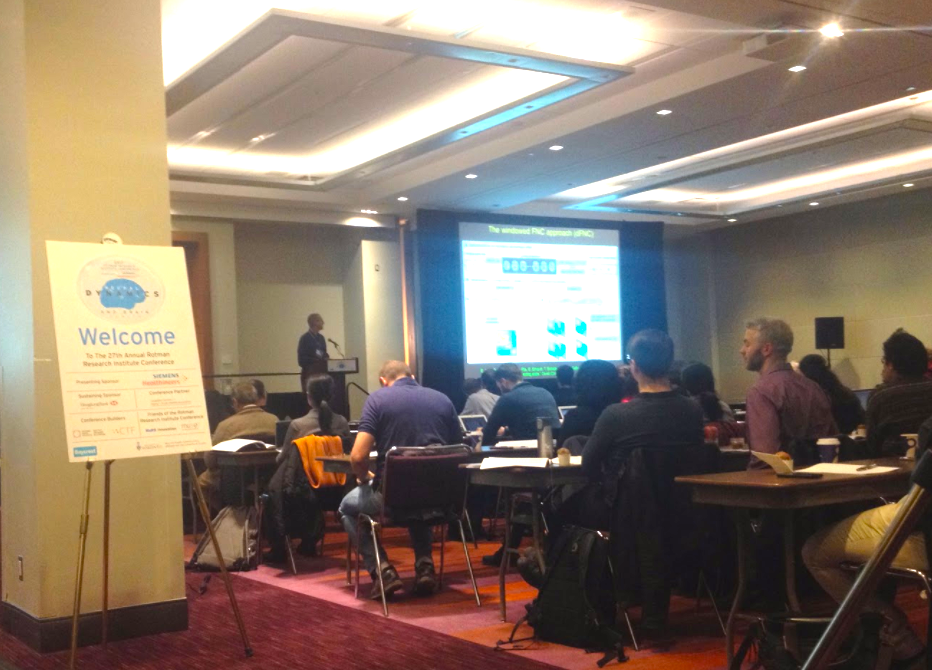|
BY JEAN CHEN For those who have not yet come across functional connectivity in their research, it won’t be long before you do. In the human brain mapping community, functional connectivity is often defined as the correlation between brain regions that share functional properties (activation patterns or fluctuations). Functional connectivity can be measured in an active or “resting” (task-less) brain state, using electrophysiological, optical and MRI methods. In recent years, the brain’s functional connectivity has begun to capture the public’s imagination in a tangible way. In 2009, the National Institutes of Health launched the Human Connectome Project to map all connections in the brain, including functional connections. This was followed by the European launch of the ambitious Human Brain Project in 2013. Today, beyond helping us to understand how the brain works, functional connectivity measurements are widely used in studying brain aging and brain diseases. Some examples include ADNI (USA), BIOCARD (USA), ONDRI (Canada), CCNA (Canada), SMART (Europe), Rotterdam Study (Europe) and the Sydney Memory and Aging Study (Australia). With the extensive use of functional connectivity in various domains, many of us have come to expect functional connectivity, like the fibre structures physically connecting different brain areas, to be more or less stable. Most studies revolve around “static” functional connectivity, averaged into a single quantity over the course of many minutes. The dominant belief is that we would like this “static connectivity” to be reproducible across multiple time points. However, more recent work has shown that getting “stable” functional connectivity measurements within individuals has been rather difficult, especially in resting-state measurements. This, for me, was when two bodies of knowledge collided. On the one hand, image-analysis research has largely been focused on making functional connectivity within an individual more “static”, i.e. more stable across time. On the other hand, many years of electrophysiological research have shown that a healthy brain is a variable brain. It would be natural to reconcile these two streams of knowledge into a coherent and more complete view of functional connectivity. Through dynamic functional connectivity, we can observe moment-to-moment (seconds apart) changes in connectivity. Yet, it had seemed to me, that by allowing functional connectivity to vary with time, we would lose a degree of tractability in this “wanna-be” biomarker. “How should it be calculated?” “How should it be interpreted?” “Should it replace conventional static functional connectivity?” The added challenges have not stopped researchers from increasingly embracing this new trend. At the recent Rotman Research Conference on Neural Dynamics, I caught up with some world authorities on dynamic functional connectivity, trying to get a sense of how dynamic connectivity should be measured and what the future holds for it. Who’s mapping dynamic functional connectivity and why? The Rotman Research Conference is an annual research conference series hosted by the Rotman Research Institute of Baycrest (University of Toronto). Since its inception in 1990, the Rotman Conference has varied its theme from year to year, but always revolving around important current concepts in cognitive neuroscience and brain aging. The objective for the 2017 conference was to showcase cutting-edge research in neuroimaging of brain dynamics and its clinical translation. Amongst the notable speakers at this year’s conference, Drs. Vince Calhoun, Viktor Jirsa, Randy McIntosh and Cheryl Grady presented their work on dynamic connectivity. “Is dynamic connectivity a natural next step in functional connectivity research?” Vince: Yes, it seems like it. We were always looking at functional connectivity associated with tasks, and even during a task block, connectivity within a brain network fluctuates. The brain is constantly variable, even at rest. By averaging connectivity across a 10-minute fMRI scan, a lot of information will be averaged out. We and others first published on this topic in 2010 and since then the field has really exploded. Functional connectivity should be measured within a dynamic context, but there may well be a mixture of both dynamic and static aspects in the data that are useful. Randy: By construction, the brain needs to be dynamic, or else it wouldn’t work very well. It is how the system is set up. Viktor: Dynamic connectivity can be more useful than static connectivity, since brain function is dynamic in nature, no matter what. Measures should not be repeatable. The brain is a nonlinear complex system, and multi-stability of the brain is a necessary feature. This is something we try to capture. Non-stationarity in brain activity is not a bad thing; it can give us much more useful information. There have been studies in which dynamic connectivity provides better prediction. “How can dynamic connectivity be measured and used?” Cheryl: In our research, we have been calculating functional connectivity dynamics, that is, connectivity over moving time windows. We then take the variability of connectivity across the windows. We find older adults demonstrating lower variability, and this is a very robust finding. There might always be issues with the sliding-window approach, but I’m not sure what the best approach would be at this moment. Randy: In the 1970’s, there was much enthusiasm for using quantitative EEG signal as a biomarker, but the signal and its mechanisms were hard to understand. The same is true for functional connectivity. Functional connectivity is a consequence of a cascade of bottom-up and top-down processes, involving molecules and genes. What’s more, functional connectivity in clinical and healthy groups may be similar on the surface but be based on different mechanisms. Dynamic connectivity provides a way to generate more features to characterize the uniqueness of each individual brain. “What does the future hold for dynamic connectivity?” Vince: Functional connectivity is progressing towards being an imaging biomarker, but is not quite there yet. I think static and dynamic connectivity remain both useful. Certain connectivity components may vary a lot and others may not vary much. In addition, integrating this information within the larger structural/functional context is important. I am a big proponent of integrating multiple modalities, and in our work, we have been jointly modeling static and dynamic connectivity, letting the data tell us what is useful. Randy: Until we can get a good understanding of the mechanisms behind functional connectivity, we will not be ready to use it as a biomarker. A biomarker ideally needs to be individualized, and it is not enough for functional connectivity to only show sensitivity when measured in a large group of individuals. For now, to find some way of concentrating the dynamic features of the individual brain would more likely lead to a biomarker. Viktor: Static functional connectivity is not a bad measure. We just need to be careful how to use it and interpret it. We may need to recognize that non-reproducibility is part of the functional process, and modeling this variability may be a solution towards individualizing functional connectivity. The mathematical modeling is likely to benefit functional connectivity in terms of personalization. Cheryl: I don’t think dynamic connectivity will replace static connectivity measures. We can still learn quite a bit from static connectivity. It can still distinguish young adults from older adults. What I hope from those that develop new data-analysis methods is an easy and reliable way to account for vascular effects in functional connectivity (and other fMRI) measures. Concluding remarks There you have it. It is likely that the only thing about the brain that’s constant is change. To help characterize it, dynamic functional connectivity may be a scalable brain measure that is accessible to neuroscientists and informatics researchers alike.
0 Comments
Your comment will be posted after it is approved.
Leave a Reply. |
BLOG HOME
Archives
January 2024
|


 RSS Feed
RSS Feed